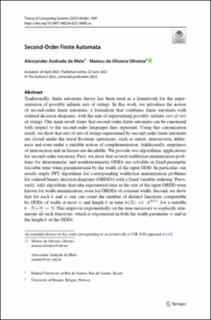| dc.contributor.author | de Melo, Alexsander Andrade | |
| dc.contributor.author | Oliveira, Mateus De Oliveira | |
| dc.date.accessioned | 2023-03-20T12:29:36Z | |
| dc.date.available | 2023-03-20T12:29:36Z | |
| dc.date.created | 2022-09-20T13:34:46Z | |
| dc.date.issued | 2022 | |
| dc.identifier.issn | 1432-4350 | |
| dc.identifier.uri | https://hdl.handle.net/11250/3059255 | |
| dc.description.abstract | Traditionally, finite automata theory has been used as a framework for the representation of possibly infinite sets of strings. In this work, we introduce the notion of second-order finite automata, a formalism that combines finite automata with ordered decision diagrams, with the aim of representing possibly infinite sets of sets of strings. Our main result states that second-order finite automata can be canonized with respect to the second-order languages they represent. Using this canonization result, we show that sets of sets of strings represented by second-order finite automata are closed under the usual Boolean operations, such as union, intersection, difference and even under a suitable notion of complementation. Additionally, emptiness of intersection and inclusion are decidable. We provide two algorithmic applications for second-order automata. First, we show that several width/size minimization problems for deterministic and nondeterministic ODDs are solvable in fixed-parameter tractable time when parameterized by the width of the input ODD. In particular, our results imply FPT algorithms for corresponding width/size minimization problems for ordered binary decision diagrams (OBDDs) with a fixed variable ordering. Previously, only algorithms that take exponential time in the size of the input OBDD were known for width minimization, even for OBDDs of constant width. Second, we show that for each k and w one can count the number of distinct functions computable by ODDs of width at most w and length k in time h(|Σ|,w) ⋅ kO(1), for a suitable \(h:\mathbb {N}\times \mathbb {N}\rightarrow \mathbb {N}\). This improves exponentially on the time necessary to explicitly enumerate all such functions, which is exponential in both the width parameter w and in the length k of the ODDs. | en_US |
| dc.language.iso | eng | en_US |
| dc.publisher | Springer | en_US |
| dc.rights | Navngivelse 4.0 Internasjonal | * |
| dc.rights.uri | http://creativecommons.org/licenses/by/4.0/deed.no | * |
| dc.title | Second-Order Finite Automata | en_US |
| dc.type | Journal article | en_US |
| dc.type | Peer reviewed | en_US |
| dc.description.version | publishedVersion | en_US |
| dc.rights.holder | Copyright 2022 The Author(s) | en_US |
| cristin.ispublished | true | |
| cristin.fulltext | original | |
| cristin.qualitycode | 1 | |
| dc.identifier.doi | 10.1007/s00224-022-10085-w | |
| dc.identifier.cristin | 2053551 | |
| dc.source.journal | Theory of Computing Systems | en_US |
| dc.source.pagenumber | 861-909 | en_US |
| dc.relation.project | Norges forskningsråd: 326537 | en_US |
| dc.relation.project | Norges forskningsråd: 288761 | en_US |
| dc.identifier.citation | Theory of Computing Systems. 2022, 66 (4), 861-909. | en_US |
| dc.source.volume | 66 | en_US |
| dc.source.issue | 4 | en_US |

